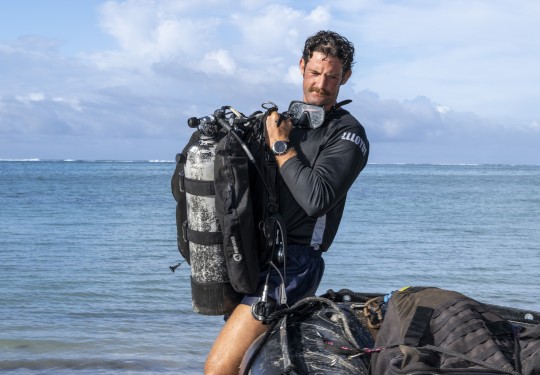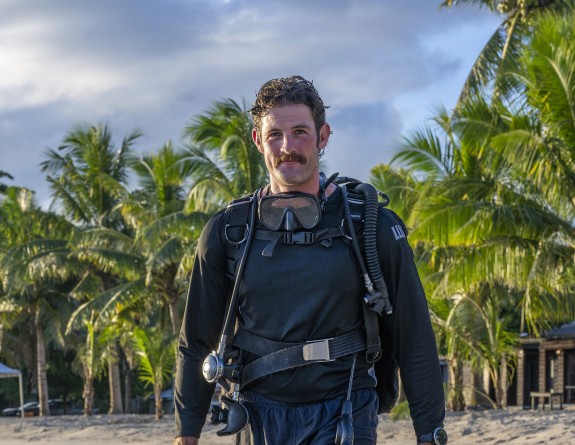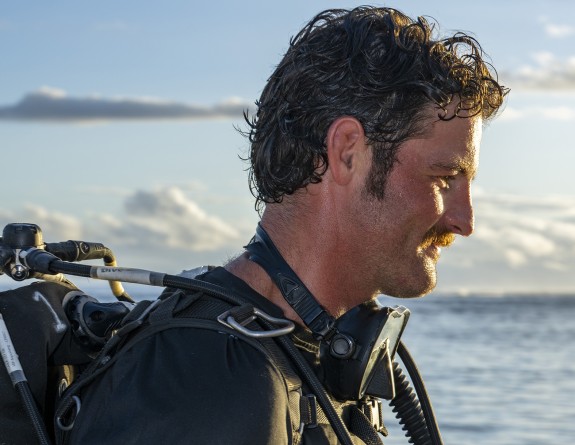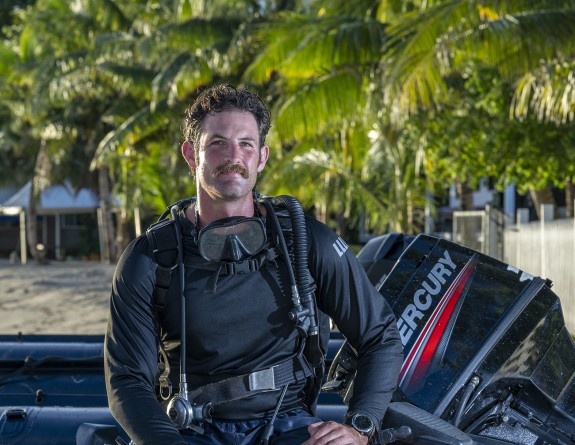Christian Lloyd, who led the Royal New Zealand Navy diving contingent in Samoa in the aftermath of the sinking of HMNZS Manawanui, is being recognised with a Chief of Defence Force commendation for his actions in dangerous and challenging conditions.

16 October, 2025
The Hutt Valley man, who went to St Patrick’s College Silverstream, transferred from the NZ Army in 2023. Since then, he’s been the Officer in Charge of the Survey, Search and Recovery (Diving) unit, which is part of HMNZS Matataua’s Mine Warfare and Clearance Diving capability.
On the evening of Saturday 5 October, 2024, Lieutenant Christian Lloyd received a phone call; Manawanui had run aground on a reef off the south coast of Upolu, the main island of Samoa, and the crew were about to abandon ship.
“I thought, is this really happening?” he says.
“Then the Executive Officer calls. ‘How quickly can you put a team together?’ And within half an hour, I was at the naval base with a small group I had managed to get hold of on that Saturday night. We quickly started loading all our equipment for deployment, raising comms with the rest of the team to get ready.”
Lieutenant Lloyd returned home in the early hours of Sunday morning to pack his bags.
“I told my partner, I didn’t know when I’d be back. That’s something I’ve never done before. Then it’s back to Devonport for briefings and final equipment checks. At this point the other divers are coming in.”
He said they were eager to go, but apprehensive.
“We had little information about the situation, and we didn’t know what state the crew were in. We had to expect a worse-case scenario.
“In 24 hours, we had arrived by a C-130 Hercules in Samoa and within 48 hours, we were in the water.”
By this time, the entire crew had been recovered safely. Manawanui had sunk and was lying on its starboard side at around 30 metres down.
“For the first 24 hours, it was all about helping local authorities with what they needed and being boots on the ground from New Zealand.
“But we needed to get on that ship, and with the help of some Australian Defence Force personnel and local government officials who knew the ground well, we found somewhere close, a beach on the southern coastline where we could launch our operations from.”



Lieutenant Christian Lloyd was the Officer in Charge of the Royal New Zealand Navy diving contingent in Samoa in the aftermath of the sinking of HMNZS Manawanui
Lieutenant Lloyd said basing operations in Apia wouldn’t have worked.
“The quickest travel route from Apia to the southern coast meant a huge change in altitude, over a mountainous range. This has major implications for us as divers. Going around the island would also hinder and prolong operations. We knew we had to stay at sea level, where we had efficient access to Manawanui.”
With the operating post established, Lieutenant Lloyd set up a safety framework and routines for his team. The first five weeks would involve surveying and monitoring of the wreck and the recovery of forensic evidence for the future Court of Inquiry.
“That was the most intense time. It was challenging, exciting and a lot of pressure. I take my hat off to my team – the divers, the logisticians, the engineers. They worked so hard.
“Manawanui had run aground and sunk in a very difficult spot. In some of that initial media footage, you see this idyllic lagoon from our launching site, but once outside the safety of the lagoon, in open water, it was very, very rough, with a heavy swell.
“And then underwater, you have the hazards that come with operating in and around a wreck. This is probably some of the most dangerous and challenging types of diving you can do. Everyone had to be switched on, the moment you got on the dive boat.”
He said everything was about risk assessment.
“To put it into context, one day you are working in or looking down a passageway or a compartment. The next day, you could dive to the same location, and it would have collapsed.
“We did that for five weeks, conducting diving operations every day. That shows just how well trained and professional the team were. I was very proud of what they achieved throughout the period of operations.”
Lieutenant Lloyd’s award citation credits his ability to remain calm and maintain the safety and wellbeing of his team in extreme conditions.
Things calmed down during subsequent deployments, he said.
The Navy dive team supported the Samoan agency responsible for sea water testing, transporting them out to the locations selected for sample collection. They also took over aerial monitoring and surveillance from Air Force personnel, launching uncrewed aerial vehicles (drones) from the beach.
“We had moved from that rapid reaction search and recovery phase – which we are really good at – to monitoring the site and supporting the contracted salvors. Once the salvors were on site, we were able provide them with information and formally hand over so they could do their job in extracting the diesel fuel.”
The experience was a huge learning curve, said Lieutenant Lloyd.
“It was intense and at times frantic, but everyone performed incredibly well. I had a really good team and I couldn’t have done it without them. Especially the range of experience and skill level from the junior rates right through to the senior divers. Everyone brought something valuable to the table.”
His commendation notes his outstanding leadership, dedication and courage, something he said all his team shares. He credits his skills to the time he spent both as a platoon commander in the NZ Army and integrating with the Navy’s Clearance Divers before service changing.
“I enjoy working with small, specialist teams. In many ways Matataua and the divers run very similar to land-based units, so it was a natural progression when I came across.
“It’s great to get a commendation. But for me, it’s recognition for the team as well. We thrived in that operationally high-risk environment and the effort by all involved was immense. We learnt a lot from the whole event. I hope it never happens again but if it ever did, we’d be ready to go.”
from WordPress
via IFTTT
No comments:
Post a Comment